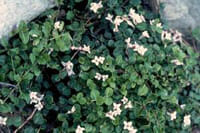Wood (Western) Trillium – Liliales Liliaceae Trillium ovatum
 |
 |
 |
 |
Identification & Description:
The trillium is a simple, graceful perennial that is one of the most familiar and beloved of the spring woodland wildflowers. Leaves, petals and sepals of all trilliums come in groups of three. This species, sometimes commonly called wood trillium, is a Missouri native that grows up to 15″ high. An unbranched, naked stem is topped by three, evenly-spaced, sessile, lanceolate to rounded, dark green, hosta-like leaves (4″ long) that are often mottled. The flower (2″ high) features three erect, greenish petals (sometimes with a yellow tinge) and three narrow, greenish sepals and appears stalkless atop the center of the three-leaf whorl. A clump-forming plant with stems arising from thick, underground rhizomes which will spread slowly if left undisturbed. Foliage will usually die to the ground by mid-summer, particularly if the soil is allowed to dry out.
Trillium have adapted themselves to using this short opportunity of light and lack of competition to become woodland jewels. Depending upon the location and species, Trillium can begin to emerge and flower at the middle to end of February. Most species however, emerge and flower from late March through the first of May. By mid July, trilliums will have completed their cycle above ground, to rest until the following spring.
Trilliums have certainly adapted well to their environment. They form an enlarged underground root called a rhizome. This rhizome has two kinds of roots. One type of root is for feeding and collecting nutrients, another for anchoring and adjusting positions in the soil. A new eye forms at the end of the rhizome each late fall to emerge as a stem with leaves and bloom the following spring. Everything is a “packet” that quickly unfolds, wasting no time. Foliage consists of three leaves, generally very broad in relation to overall plant size for efficient collection of light.
There are some forty-odd species within the genus Trillium, depending upon the expert being read or quoted. The exact number of species remains a much-heated debate. The old division between ‘splitters’ and ‘lumpers’ in taxonomy is very much in evidence with the genus Trillium.
The genus has a very odd distribution pattern. The greatest number of species are found in North America. Within North America, most species are located east of the Rocky Mountains, from the Great Lakes to Florida. From North America the genus jumps to a line drawn from Siberia, Korea, Japan and China to the Himalayas, completely skipping Europe.
Trillium foliage can be as colorful as some blooms, and is worth bringing to the garden for its fleeting beauty. Frequently the local T. sessile, T. recurvatum and T. luteum species will have mottling on the leaves aligned along the veins. Each plant will vary in amount and intensity of mottling. Color mix can vary as well, both from species to species and plant to plant within species. I believe my local favorite to be T. luteum with its deep green leaves, mottled along the veins in silver-pewter, and overlaid with a hint of lemon-yellow.
When using Trillium in the garden, the early dormancy can be used to advantage. They can be planted among the roots of mature trees and shrubs where little else will thrive. There are also ferns that will stand up to root competition once established. Since most ferns do not emerge or put up new foliage until relatively late in the season, they can occupy the space vacated by the trilliums.
Just as with any other bulb or tuber, trilliums respond to good garden soil and protection from root competition.
Characteristics
• Family: Lily (Liliaceae)
• Habitat: peaty or acid woods
• Height: 10-20 inches
• Flower size: 1-1/2 inches across
• Flower color: white, occasionally pink
• Flowering time: April to June
• Origin: native